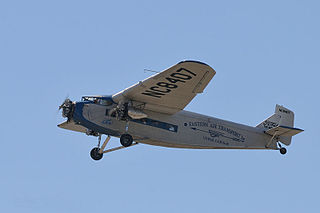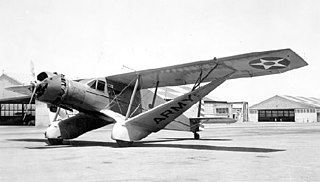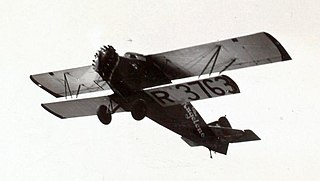
The Lockheed Vega is an American six-passenger high-wing monoplane airliner built by the Lockheed Corporation starting in 1927. It became famous for its use by a number of record-breaking pilots who were attracted to the rugged and very long-range design. Amelia Earhart became the first woman to fly solo across the Atlantic Ocean in one, and Wiley Post used his to prove the existence of the jet stream after having flown around the world twice.

The Lockheed Constellation ("Connie") is a propeller-driven, four-engined airliner built by Lockheed Corporation starting in 1943. The Constellation series was the first pressurized-cabin civil airliner series to go into widespread use. Its pressurized cabin enabled commercial passengers to fly well above most bad weather for the first time, thus significantly improving the general safety and ease of air travel.

Canadian Pacific Air Lines was a Canadian airline that operated from 1942 to 1987. It operated under the name CP Air from 1968 to 1986. Headquartered at Vancouver International Airport in Richmond, British Columbia, it served domestic Canadian as well as international routes until it was purchased by Pacific Western Airlines and absorbed into Canadian Airlines International.

Santa Barbara Municipal Airport is 7 miles (11 km) west of downtown Santa Barbara, California, United States. SBA covers 948 acres of land.
The Lockheed Model 10 Electra is an American twin-engined, all-metal monoplane airliner developed by the Lockheed Aircraft Corporation in the 1930s to compete with the Boeing 247 and Douglas DC-2. The type gained considerable fame as one was flown by Amelia Earhart on her ill-fated around-the-world expedition in 1937.

The Ford Trimotor is an American three-engined transport aircraft. Production started in 1925 by the companies of Henry Ford and ended on June 7, 1933. A total of 199 Ford Trimotors were made. It was designed for the civil aviation market, but also saw service with military units.
This is a list of aviation-related events from 1931:
This is a list of aviation-related events from 1926:
This is a list of aviation-related events from 1929:

The Lockheed Model 18 Lodestar is a passenger transport aircraft of the World War II era.

Lituanica was a Bellanca CH-300 Pacemaker airplane flown from the United States across the Atlantic Ocean by Lithuanian pilots Steponas Darius and Stasys Girėnas in 1933. After successfully flying 6,411 km, it crashed, due to undetermined circumstances, 650 km from its destination, Kaunas, Lithuania.

A bush airplane is a general aviation aircraft used to provide both scheduled and unscheduled passenger and flight services to remote, undeveloped areas, such as the Canadian north or bush, Alaskan tundra, the African bush, or savanna, Amazon rainforest or the Australian Outback. They are used where ground transportation infrastructure is inadequate or does not exist.

The Bellanca Aircruiser and Airbus were high-wing, single-engine aircraft built by Bellanca Aircraft Corporation of New Castle, Delaware. The aircraft was built as a "workhorse" intended for use as a passenger or cargo aircraft. It was available with wheels, floats or skis. The aircraft was powered by either a Wright Cyclone or Pratt and Whitney Hornet engine. The Airbus and Aircruiser served as both commercial and military transports.

Wien Air Alaska was a United States airline formed from NorthernConsolidated Airlines(NCA) and Wien Alaska Airways. The company was famous for being the first airline in Alaska, and one of the first in the United States; it ceased operations 38 years ago on 23 November 1984 when it was operating as Wien.
Noel Wien was an American pioneer aviator. He was the founder of Wien Alaska Airways.

The Buhl AirSedan was a family of American civil cabin sesquiplane aircraft developed and manufactured by the Buhl Aircraft Company in the late 1920s. One example completed the first transcontinental non-stop roundtrip flight, made in 1929 by the CA-6 Spokane Sun-God, and the first Pope to have flown did so in a Buhl Airsedan.

The Travel Air 6000 was a six-seat utility aircraft manufactured in the United States in the late 1920s.
Alaska Coastal Airlines was an airline in the United States. It was formed in 1939 as a result of the merger of Alaska Air Transport and Marine Airways. On April 1, 1962, Alaska Coastal Airlines merged with Ellis Air Lines, trading for a while as Alaska Coastal-Ellis Airlines. Alaska Coastal Airlines was taken over by Alaska Airlines in April 1968.
Star Air Service, later Star Air Lines and Alaska Star Airlines was an American air service in Alaska from 1932 to 1944. With financial help from a wealthy Alaska miner, three pilots who had started a flying school and charter business in Seattle, shipped an open-cockpit biplane by steamship to Alaska in March 1932. Star Air Service was incorporated in April, 1932 in Anchorage with capitalization of $4,000. The company had some early success training student pilots, but their airplane was destroyed in a crash. Their financial backer helped them purchase a larger plane with an enclosed cabin which supported winter operations.

Hawaii's first aeronautical event was on 2 March 1889, when Emil L. Melville hung from a trapeze in a balloon. Hawaii's first aircraft flight was on 31 December 1910 by a Curtiss Biplane.

















